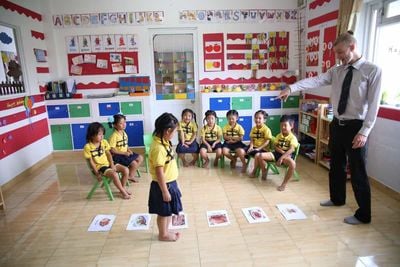4 Super Easy Tips for Teaching Vocabulary to Young Learners

When students hear 'vocabulary', they may expect to hear the word 'list' next. More often than not, we associate the word 'list' with 'boring'! We think of 2 daunting columns of black letters on white paper: one with the native language and one with the target language. But it doesn't have to be that way, and for teaching young learners, it cannot be that way. Certainly, teaching vocabulary will involve lists that help learners to receive language methodically and thoroughly. But what a teacher does with the vocabulary lists can be creative and fun and, most of all, memorable!
Table of Contents
Using Visuals - Loads of Them!
Teaching Vocabulary Using the ESA Methodology
Teaching Adjectives Using Opposites
Are you ready to teach English abroad?
This post was written by our ITTT graduate Roxanne L.
Using Visuals - Loads of Them!
When teachers hear 'vocabulary', they should pair it with the word 'visual'. According to Inc.com, 65% of people are visual learners. We should take that into account no matter who we teach, but as teachers of English learners, we should plan to incorporate visual aids in our teaching of vocabulary whenever possible. On top of that, if we are teaching early readers or even pre-readers, visual vocabulary is a must! Thanks to high-speed Internet and sophisticated search engines, a visual representation of every word we've ever wanted to teach is at a teacher's fingertips. So for vocabulary, teachers of young children should definitely have one of two things prepared: either a real-life object to let the children interact with, or at least one slide or flashcard with the new vocabulary word and a picture or clipart illustrating the word. If teachers are using the ESA style of lesson planning, the real-life object is a great way to engage the students and get them talking and thinking in English.

Teaching Vocabulary Using the ESA Methodology
Engaging students in vocabulary acquisition is easy when teaching nouns; showing a picture or real life object will suffice. Once the students understand that the picture or real life object is a person, place or thing, they can begin using the vocabulary words which are nouns in sentences. The study phase of the lesson could involve a gap-fill or copying exercise. For the activate stage, students could pass the object around the room. The student starting out could hold the object (say for example a cabbage) out to her classmate and say, "This is a cabbage." When the next child takes the cabbage from her, he can pretend that the didn't hear, "A what?" She will say, "A cabbage." The receiver will say, "Oh, I know! It's a cabbage." Depending on the students' ages, the teacher may lead the students in sentence invention or story writing about this new vocabulary word they've received.

Acting Out Verbs
Teaching verbs and adjectives with a picture can be ambiguous. If you show a picture of a girl in a red shirt running to teach the verb 'run', students may get confused and forever associate 'girl' with 'run' or 'red' with 'run'! Ideally, teachers will act out the vocabulary words which are verbs and/or show several videos of the verb in action. Once the students understand that the teacher is demonstrating an action, the students can practice conjugating the verbs in various sentences during the study phase. The activate phase could include a bag filled with cards with verbs on them. Students could reach into the bag and choose to either draw or mime the verb to his/her classmates as a game of Pictionary or charades.

Teaching Adjectives Using Opposites
For adjectives, use of contrast often helps. If a teacher is trying to show an adjective like 'light' she will have to contrast it with 'heavy' or 'dark'. This contrast could be represented on slides or flashcards, but it is a good idea to have several versions to clarify what attribute is being illustrated. For example, when teaching an adjective like 'old', you may contrast an old car and a new car, placing an 'X' over the new car and circling the old one. But to be sure the students don't think it is to illustrate dirty versus clean or cheap versus expensive, you may have to have a few other contrasting pairs, like an old lady and a young lady or an old paper and a new paper. For the study phase, gap-fill exercises, whether oral or written, would be useful to verify if the students understand they are learning a descriptive word. The activate stage could include pair work where students describe a painting that their classmates have not seen. Each pair would read their descriptions aloud whilst the other pairs try to draw what they hear being described.
Listen to this blog post
Are you ready to teach English abroad?
Learning vocabulary lists can be fun and memorable if the teacher makes an effort to incorporate visual elements in the lesson. It's how we learned our native language if we are not blind. So it makes sense to closely imitate the process if we want to learn another language. By seeing objects, actions and characteristics, our students can quickly learn new vocabulary and retain the new vocabulary permanently!
Apply now & get certified to teach english abroad!
Speak with an ITTT advisor today to put together your personal plan for teaching English abroad.
Send us an email or call us toll-free at 1-800-490-0531 to speak with an ITTT advisor today.



